Face-Off: Just Cause 3
Cause and effect.
Following on from Mad Max, Avalanche Studios throws out gritty post-apocalyptic landscapes for Just Cause 3 in favour of a vibrant and bombastic open world action title, where the emphasis is firmly on crazy stunts and rampant destruction. Spectacle is what this series is all about, and in this regard Just Cause 3 certainly delivers - the question is whether the underlying technology is capable of fully delivering the necessary pyrotechnics while retaining its 30fps performance target.
Of course, in theory, the Avalanche engine should be well suited to delivering this type of experience - in essence, that's exactly what it was built for. Going into this game, we had every reason to be confident that the studio would deliver. Mad Max handed in the goods on all three platforms, and remains one of the very few technologically challenging triple-A titles to deliver an almost entirely identical experience between Xbox One and PlayStation 4, with a consistent level of performance to boot.
However, Just Cause 3 is a somewhat different animal - as our initial analysis revealed. While there's little doubt that the core action delivers, the surrounding technology is clearly feeling the strain on console, and our first tests on our budget gaming PC platform suggested that the computer version may well offer the best available experience. The only problem is that there's a sting in the tail there - specifically, a notable level of instability. Avalanche has promised a patch and asked for patience in its delivery. Having spent a week with the PC version, the almost random nature of certain issues is very annoying - and that's a shame. It's a beautiful game, offering limited but effective visual enhancements over the two console releases, but the ability to iron out the performance issues and hit a sustained 60fps clearly elevates the gameplay.
In terms of console basics, PlayStation 4 produces a native 1080p image, while Xbox One brings a 900p framebuffer to the table, with both using a post-process solution for anti-aliasing very much akin to the FXAA option on PC. The PS4 game more closely matches up to PC in terms of raw pixel sharpness, but the anti-aliasing options available on PC are a key point of difference. Coverage is decent on console, although long edges and distant objects fall to pixel-popping artefacts. Xbox One fares a little worse here due to the drop in resolution, but for the most part there isn't too much in it between the two. Texture details appear slightly more smoothed over in still scenes, but the game's use of camera blur in motion helps to even out the presentation to the point where the drop in resolution is often barely perceivable during gameplay.
For those wanting a lightweight anti-aliasing solution, FXAA is also available on the PC version delivering similar results to PS4. However, it's also possible to achieve more refined levels of image quality via use of SMAA. Basic SMAA provides smoother imagery than on consoles with better coverage across the usual sub-pixel objects and on foliage. A T2x variant of SMAA is also available which adds a temporal component that helps to tackles additional jaggies. However, the effect doesn't appear to be implemented properly - it adds a small amount of ghosting in motion that some may find distracting. Again, this looks like a bug that perhaps should have been addressed pre-launch.
In terms of overall image quality, the PC game comes out on top, but what's particularly interesting is the way in which it's possible to scale back on graphical presets without massively impacting on the core visual quality of the game. Indeed, taking a look between very high, high, and medium presets, visual differences are actually quite subtle. As we move through the various quality levels we find elements such as distant buildings featuring slightly lower quality LOD models in a few places, along with the removal of some walls, fences, and lamp posts that are far away from the player.
In like-for-like comparisons, the tweaks to environmental details are visible, though during gameplay, the fast-paced action makes the streaming differences very difficult to pick up on. Moving down from very high to high yields only a subtle reduction in quality, while jumping down to low incurs a more noticeable effect where texture detail is clearly compromised in a number of areas - but it's actually the shadow preset that has the most impact to overall image quality. We wouldn't recommend dropping it below high.
The real takeaway here is that it's possible to claw back additional performance without sacrificing the core graphical quality to a significant degree during gameplay. Draw distances remain impressive with trees and other little details visible for miles in the distance, while it's possible to balance out texture and shadow detail so that the downgrade is often a pretty subtle compared with the game running maxed out - as long as you leave the toggle effects on - such as motion blur, depth of field, and global illumination. Of course, these do incur the highest costs on overall performance, but we could run with these active even on our budget PC.
On consoles, Avalanche carefully selects which elements to scale back on. Assets and settings are seemingly taken from a range of PC presets, with the developer adjusting the level of graphical quality in order to strike a balance between raw detail and performance. For example, texture quality on PS4 and Xbox One seems to match the very high setting on PC (though there's little difference between high and very high), LOD factor is a curious one, often aligning closely with PC's low setting, while shadows closely resemble those running on high on the PC game. Nvidia Waveworks is also deployed on console, with water splashes produced by speedboats replicated evenly across all platforms. However, we did note that extreme wave draw distance does take a hit - look out over the ocean from a hill-top and waves resolve on PC where they are absent on console.
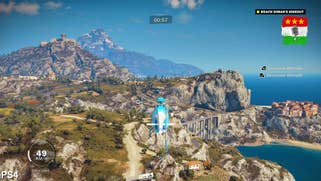
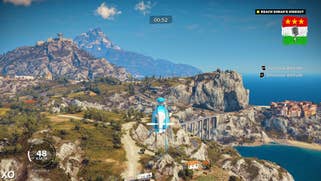


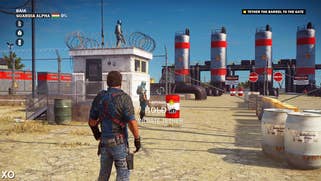






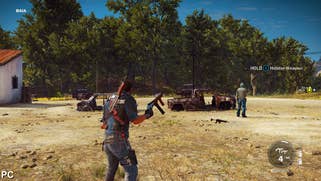



All in all, the console versions of Just Cause 3 hold up rather well compared to the maxed out PC version in terms of the game's complete visual feature set. Draw distances are impressive across all three platforms, and it's a surprise to see PS4 and Xbox One rendering out tiny trees and pylons at the same distances as the PC game. Granted, some objects are rendering with lower quality LODs, but all the main elements are present on screen, and this goes a long way to hiding the differences outside of like-for-like screen comparison. Aside from the resolution difference, both consoles mostly appear like-for-like in other areas. On occasion we see assets streaming in faster on one platform than the other - and vice-versa - but the core art and effects work are basically a match, and it should be stated that the PC version isn't averse to some streaming glitches either, even running from SSD.
That said, moving up to very high on PC provides some improvements. Shadows appear sharper and more defined and LOD transitions occur a little more quickly, resulting in a few elements of scenery using higher quality assets from further away than on console. Ramping up anisotropic filtering sees texture details resolve more clearly across oblique angles both on near field and distance surfaces (though the effect isn't quite as good as it should be - using the GPU control panel option may produce better results). By comparison, consoles operate with at something in the region of 2x to 4x AF leading to blurrier artwork in similar scenes. PC owners also get a mild heat haze effect deployed near the horizon, which slightly blurs and distorts objects within its radius - a form of atmospheric rendering, if you will. It's subtle, but very effective.
In other areas motion blur, depth of field, ambient occlusion lighting, and the use of global illumination are identical across all three formats - though the latter feature is bugged on PC, and can produce an off-putting strobe effect. SSAO is responsible in creating the indirect shadowing on all three formats, with the effect creating some soft halos around Rico when he moves past close-range scenery.


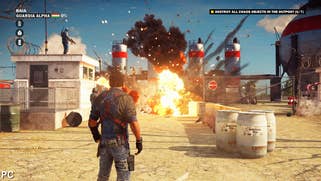












The global illumination technique deployed in Just Cause 3 is particularly interesting though, with Avalanche Studios carefully applying the effect in moderation so that the GPU isn't overburdened in rendering multiple light bounces across the entire environment. The effect is only activated in close proximity to Rico, with scenery in the distance featuring a simpler lighting model. This allows for extra depth to areas immediately close to the player - where such details will be noticed - without incurring a game breaking performance hit.
From a core graphical perspective, both consoles hand in a decent presentation, with PS4 taking a small lead in terms of raw pixel sharpness and clarity. However, things appear shakier when looking at performance, where both machines struggle in action-heavy scenes where the engine really lets rip with an array of alpha-based effects and physics powered environmental destruction. Both consoles target a 30fps update and adaptive v-sync is used to help reduce latency and stutter by allowing for tearing to appear at the top of the screen - in short, in common with many recent titles, Just Cause 3 has a certain elasticity to its render budget. Torn frames are rarely an issue though, with your viewpoint frequently directed to the centre of the screen. Instead, frame-rates are more of a cause for concern, particularly when the action heats up.
Indeed, outside of more sedate moments of performance is frequently impacted across both PS4 and Xbox One when the engine is put to the test. Large firefights often end up in a fury of explosions and particle effects as cars and select structures are levelled to the ground. Watching the scenery get ripped apart through conflict is one of the high points of Just Cause 3, with the game boasting a similar visual excess to a Michael Bay blockbuster. However, these points also act as a stress test for the engine and ultimately it often fails to keep up with the demands placed on it.
Large explosions and heavy deployment of alpha transparencies clearly have a tangible impact on performance across both consoles, with sub-30fps metrics rolling out when the engine is put under stress in intense firefights. CPU-driven physics also seem to be a bottleneck in some scenarios.
We ran the performance video above earlier in the week and were looking to follow up with a more stringent stress test, but based on our results, it actually requires just one screenshot to illustrate the major concern we have with the game, and it's a particular issue on Xbox One. Check out the frame-times in the shot below (click to expand). PlayStation 4 drops frames and we see dips from the 33ms render time target, dropping down to 50ms and even 66ms on occasion. This is far from ideal. But take a look at Xbox One - not only are we nowhere near the 33ms target, drops to 66ms and even 83ms are apparent. This snapshot of 'in the moment' gameplay during an explosive moment illustrates a real issue with Just Cause 3 - in the heat of the action, you need frame-rates to be at their best. Instead, they're at their worst.
This is where the PC version can make a real difference. We have a full performance article upcoming here, but the headlines thus far are very straightforward - if you're looking to max the game at 1080p, a quad-core Intel processor is required and you'll need a GTX 970. AMD's Radeon R9 390 offers very close performance, but there is some noticeable stutter, and in our tests we used a top-of-the-line Core i7 6700K - that's a tremendously fast piece of kit. Assuming we have eliminated CPU as a potentially bottleneck, and that the stuttering isn't present on Nvidia cards, attention turns once more to the quality of the AMD driver.
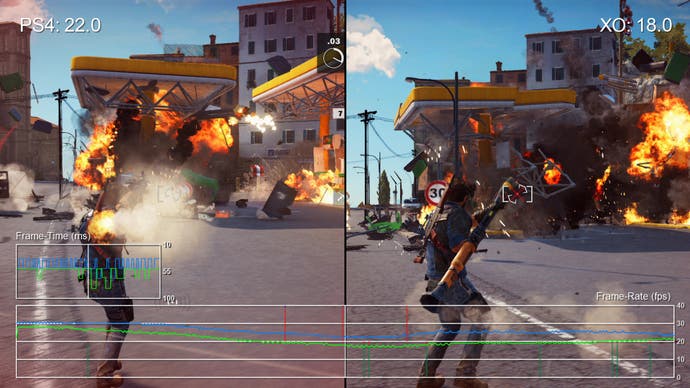
As we move down the stack, pairing less capable GPUs with less powerful graphics cards to match gaming PC set-ups of various budgets, the stutter issue on AMD cards seems to become more pronounced, the issue always manifesting exactly when you want it to happen least - during intense firefights, and often as we speed from location to location. It's a bit of a shame to be honest, and it seems that once again the software layer is letting down the excellent hardware. AMD's R7 360 provides higher overall frame-rates than the GTX 750 Ti, a situation we also see with the R9 380 up against the GTX 960. But the stutter can be intrusive - and it's simply not there on Nvidia cards. Performance can be improved by tweaking quality settings, but the hitching and stuttering can't.
It may well be a driver-related issue - something we see more often than we should with AMD cards. Right now, we've only tested Core i3, i5 and i7 processors. Unfortunately, our copy of the game managed to deactivate itself when we moved onto testing on an FX-8350 - hopefully we can get that sorted shortly, but we are aware of reports of poor performance when AMD CPUs are matched with the firm's GPUs, something we hope to look into.
When Just Cause 3 behaved as it should we enjoyed a best-in-class experience on PC, but we encountered significant stability issues during our testing. On one system, the game consistently hard-crashes within seconds of starting gameplay. On two i7 PCs running high-end Nvidia cards, we encountered no problems whatsoever and could play for hours without issue. However, on an i5 set-up, we encountered intermittent crashes. The frustrating thing is that it seems to be pot luck as to whether you'll be affected or not - that patch just can't come quickly enough.
Just Cause 3 - the Digital Foundry verdict
Just Cause 3 is a technologically ambitious, absolutely beautiful open world game on all three platforms, but it's difficult to avoid the feeling that the title is simply too much for the consoles to handle effectively. When the explosive action is at its heights, performance can drop down to the low to mid-20s, and dips are even lower on Xbox One. But frame-rates by their very nature are averages - it's the 'in the second' metrics that are most alarming - 66ms and 83ms stutter in the game's most action-packed moments has to be addressed.
Of the two versions, it's clearly the PlayStation 4 release that is preferable. The resolution increase is welcome, if not exactly a major boon during gameplay, but it's the less impacted performance level that sees it take point. You won't escape the frame-time latency issues in the thick of the action, but at least the worst excesses are blunted, to a certain extent. It's going to be really hard for Avalanche to comprehensively address this specific issue, but it's clear that optimisation should be a priority there for any future update. On top of that, the developer really needs to address the loading time issues. Here we found another PS4 advantage - anything up to a minute faster than the Xbox One version, though curiously restarting after a checkpoint saw load times virtually equalise between the two platforms.
All of which should put the PC version in pole position. Our budget PC makes a good fist of the game running with image quality settings that gives us key enhancements over the console version, and moving up to a more mainstream Core i5 gaming PC offers up a night and day improvement in terms of performance. On top of that, running from an SSD offers an immense boost to loading times. It's still drawn out on the initial load, but checkpoint restarts are much, much faster. Of course, the PC version has its own issues - the question marks surrounding overall stability there, plus hitching on the AMD cards we tested may make you think twice.
Hopefully, the console versions will get the extra round of optimisation they really need, while the various instabilities in the PC version will be addressed. Right now, Just Cause 3 can still be brilliantly entertaining - at its heart it's perhaps the most fun, exciting open world game of the generation. It's just somewhat frustrating that the launch code just feels like it's not quite ready for show-time.


















